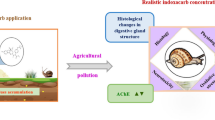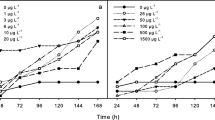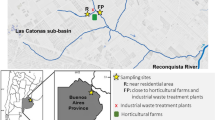Abstract
Purpose
Methiocarb and metaldehyde are the most common molluscicides applied in agricultural and horticultural fields in Portugal and elsewhere in Europe. The application of molluscicidal baits to control slug and snail populations can pose a threat to non-target organisms like terrestrial isopods, because they are detritivorous and may feed on the toxic baits applied to the soil surface. The aim of this work was to evaluate the effects and understand the modes of action of these molluscicides to terrestrial isopods.
Materials and methods
In this study, the terrestrial isopod Porcellionides pruinosus was exposed to these two molluscicides, and the time to lethality was evaluated. Biochemical indicators (biomarkers) are known to provide early warning signs of environmental pollution or stress conditions to the organisms, by measuring cellular or molecular responses of the target organism to xenobiotic agents. Therefore, to evaluate modes of action and effects and also to see if biomarkers can be used as early warning tools in molluscicidal exposures, three different enzymes, glutathione S-transferase (GST), acetylcholinesterase (AChE) and catalase (CAT), were analysed upon single exposures and binary mixtures tests.
Results and discussion
These two molluscicides showed to be of extreme concern regarding terrestrial isopods, as all animals died after 24 h of exposure to methiocarb, and only 20% survived after 56 h of exposure to metaldehyde. Results indicate that the carbamate methiocarb inhibited significantly AChE activity, but no effects were observed in CAT and GST levels. The exposure to metaldehyde had no effects on AChE, but a decrease in GST activity as well as a general increase in CAT activity was observed at the higher exposure period tested (32 h). The combined exposure of the two molluscicides resulted in a general decrease in AChE and CAT activity, but no visible effects were observed in terms of GST activity.
Conclusions
The LT50 values found in the single exposures to both molluscicides were very low, especially in the case of the carbamate methiocarb. The use of several biomarkers was a suitable tool to understand the mode of action of these two molluscicides in this isopod species.




Similar content being viewed by others
References
Bailey SER (2002) Molluscicidal baits for control of terrestrial gastropods. In: Barker GM (ed) Molluscs as crop pests. CABI Publishing, Wallingford, pp 33–54
Bieri M (2003) The environmental profile of metaldehyde. In: Henderson IF (ed) Slugs and snails. In World Agriculture, British Crop Protection Council, Symposium Proceedings 80, pp 255–260
Bocchetti R, Regoli F (2006) Seasonal variability of oxidative biomarkers, lysosomal parameters, metallothioneins and peroxisomal enzymes in the Mediterranean mussel Mytilus galloprovincialis from Adriatic Sea. Chemosphere 65:913–921
Boran M, Altinok U, Çapkin E, Karaçam H, Biçer V (2007) Acute toxicity of carbaryl, methiocarb, and carbosulfan to the rainbow trout (Oncorhynchus mykiss) and Guppy (Poecilia reticulata). Turk J Vet Anim Sci 31:39–45
Brown PJ, Long SM, Spurgeon DJ, Svendsen C, Hankard PK (2004) Toxicological and biochemical responses of the earthworm Lumbricus rubellus to pyrene, a non-carcinogenic polycyclic aromatic hydrocarbon. Chemosphere 57:1675–1681
Clairborne A (1985) Catalase activity. In: Greenwald R (ed) Handbook of methods for oxygen radical research. CRC Press, Boca Raton, pp 283–284
Crane M, Sildanchandra W, Kheir R, Callaghan C (2002) Relationship between biomarker activity and developmental endpoints in Chironomus riparius Meigen exposed to an organophosphate insecticide. Ecotox Environ Saf 53(3):361–369
Diamantino TC, Almeida E, Soares AVMV, Guilhermino L (2001) Lactate dehydrogenase activity as an effect criterion in toxicity tests with Daphnia magna straus. Chemosphere 45:553–560
Drobne D, Blažič M, Van Gestel CAM, Lešer V, Zidar P, Jemec A, Trebše P (2008) Toxicity of imidacloprid to the terrestrial isopod Porcellio scaber (Isopoda, Crustacea). Chemosphere 71:1326–1334
Ellman GL, Courtney KD, Andres VJ, Featherstone R (1961) A new and rapid colorimetric determination of acetylcholinesterase activity. Biochem Pharmac 7:88–95
El-Wakil HB, Radwan MA (1991) Biochemical studies on the terrestrial snails Eobania vermiculata (Müller) treated with some pesticides. J Environ Sci Health Part B 26(5–6):479–489
Engenheiro EL, Hankard PK, Sousa JP, Lemos MF, Weeks JM, Soares AMVM (2005) Influence of dimethoate on acetylcholinesterase activity and locomotor function in terrestrial isopods. Environ Toxicol Chem 24(3):603–609
Ferrari A, Venturino A, D'Angelo AMP (2007) Effects of carbaryl and azinphos methyl on juvenile rainbow trout (Oncorhynchus myskiss) detoxifying enzymes. Pest Biochem Physiol 88:134–142
Fischer E, Farkas S, Hornung E, Past T (1997) Sublethal effects of an organophosphorus insecticide dimethoate on the isopod Porcellio scaber. Comp Biochem Physiol 116C(2):161–166
Fulton MH, Key PB (2001) Acetylcholinesterase inhibition in estuarine fish and invertebrates as an indicator of organophosphorus insecticide exposure and effects. Environ Toxicol Chem 20(1):37–45
Guilhermino L, Lopes MC, Carvalho AP, Soares AMVM (1996) Inhibition of acetylcholinesterase activity as effect criterion in acute tests with juvenile Daphnia magna. Chemosphere 32:727–738
Habig H, Pabst MJ, Jakoby WB (1974) Glutathione S-transferase, the first enzymatic step in mercapturic acid formation. J Biol Chem 249:7130–7139
Hayes JD, Pulford DJ (1995) The glutathione S-transferase supergene family: regulation of GST and the contribution of the isoenzymes to cancer chemoprotection and drug resistance. Crit Rev Biochem Mol 30:445–600
Henderson I, Triebskorn R (2002) Chemical control of terrestrial gastropods. In: Barker GM (ed) Molluscs as crop pests. CABI Publishing, Wallingford, pp 1–31
Howcroft CF, Amorim MJB, Gravato C, Guilhermino L, Soares AMVM (2009) Effects of natural and chemical stressors on Enchytraeus albidus: can oxidative stress parameters be used as fast screening tools for the assessment of different stress impacts in soils? Environ Int 35:318–324
Hyne RV, Maher WA (2003) Invertebrate biomarkers: links to toxicosis that predict population decline. Ecotoxicol Environ Saf 54:366–374
Jemec A, Drobne D, Tišler T, Trebše P, Ros M, Sepčić K (2007) The applicability of acetylcholinesterase and glutathione S-transferase in Daphnia magna toxicity test. Comp Biochem Physiol Part C: Toxicol Pharmacol 144:303–309
Jemec A, Drobne D, Remskar M, Sepčić K, Tisler T (2008) Effects of ingested nano-sized titanium dioxide on terrestrial isopods (Porcellio scaber). Environ Toxicol Chem 27(9):1904–1914
Jensen S (1998) Acetylcholinesterase activity associated with methiocarb resistance in a strain of Western Flower Thrips, Frankliniella occidentalis (Pergande). Pestic Biochem Physiol 61:191–200
Khessiba A, Roméo M, Aïssa P (2005) Effects of some environmental parameters on catalase activity measured in the mussel (Mytilus galloprovincialis) exposed to lindane. Environ Poll 133:275–281
Köhler HR, Hiittenrauch K, Berkus M, Gräff S, Alberti G (1996) Cellular hepatopancreatic reactions in Porcellio scaber (Isopoda) as biomarkers for the evaluation of heavy metal toxicity in soils. Appl Soil Ecol 3(1):1–15
Köhler HR, Knödler C, Zanger M (1999) Divergent kinetics of hsp70 induction in Oniscus asellus (Isopoda) in response to four environmentally relevant organic chemicals (B[a]P, PCB52, g-HCH, PCP): suitability and limits of a biomarker. Arch Environ Contam Toxicol 36:179–185
Loureiro S, Sousa JP, Nogueira AJA, Soares AMVM (2002) Assimilation efficiency and toxicokinetics of 14C-lindane in the terrestrial isopod Porcellionides pruinosus: the role of isopods in degradation of persistent soil pollutants. Ecotoxicol 11:481–490
Loureiro S, Soares AMV, Nogueira AJA (2005) Terrestrial avoidance behaviour tests as screening tool to assess soil contamination. Environ Poll 138:121–131
Loureiro S, Amorim MJB, Campos B, Rodrigues SMG, Soares AMVM (2009) Assessing joint toxicity of chemicals in Enchytraeus albidus (Enchytraeidae) and Porcellionides pruinosus (Isopoda) using avoidance behaviour as an endpoint. Environ Pollut 157(2):625–632
Maran E, Fernández M, Barbieri P, Font G, Ruiz MJ (2009) Effects of four carbamate compounds on antioxidant parameters. Ecotox Environ Saf 72:922–930
Massa R, Blevins S, Chao SL (2008) Role of acetylcholinesterase and glutathione S-transferase following exposure to nicosulfuron and diazinon in Helicoverpa zea. Ecotoxicol Environ Saf 71:230–235
Meredith RH (1996) Testing bait treatments for slug control. In: Henderson IF (ed) Slug and snail pests in agriculture. British Crop Protection Council, Farnham, pp 157–164
Mills JD, McCrohan CA, Bailey SER, Wedgwood MA (1990) Effects of metaldehyde and acetaldehyde on feeding responses and neuronal activity in the snail Lymnaea stagnalis. Pestic Sci 28:189–199
Mills JD, McCrohan CR, Bailey SER (1992) Electrophysiological responses to metaldehyde in neurones of the feeding circuitry of the snail Lymnaea stagnalis. Pestic Biochem Physiol 42(1–2):35–42
Peakall DB (1999) The use of biomarkers in hazard assessment. In: Peakall DB, Colin HW, Migula P (eds) Biomarkers: a pragmatic basis for remediation of severe pollution in Eastern Europe. Kluwer Academic Publishers, Dordrecht, Netherlands, pp 123–133
Putachakayala SM, Ram JL (2000) Toxic and excitatory effects of the molluscicide metaldehyde on the biofouling bivalve Dreissena polymorpha Pallas. Pest Manag Sci 56:39–42
Radwan MA, Essawy AE, Abdelmeguied NE, Hamed SS, Ahmed AE (2008) Biochemical and histochemical studies on the digestive gland of Eobania vermiculata snails treated with carbamate pesticides. Pestic Biochem Physiol 90:154–167
Ribeiro S, Guilhermino L, Sousa JP, Soares AMVM (1999) Novel bioassay based on acetylcholinesterase and lactate dehydrogenase activities to evaluate the toxicity of chemicals to soil isopods. Ecotoxicol Environ Saf 44:287–293
Ribera D, Narbonne JF, Arnaud C, Saint-Denis M (2001) Biochemical responses of the earthworm Eisenia fetida andrei exposed to contaminated artificial soil, effects of carbaryl. Soil Biol Biochem 33:1123–1130
Roberts AP, Oris JT (2004) Multiple biomarker response in rainbow trout during exposure to hexavalent chromium. Comp Biochem Physiol Part C: Toxicol Pharmacol 138:221–228
Schlenk D (1999) Necessity of defining biomarkers for use in ecological risk assessments. Mar Pollut Bull 39(1–12):48–53
Schreck E, Geret F, Gontier L, Treilhou M (2008) Neurotoxic effect and metabolic responses induced by a mixture of six pesticides on the earthworm Aporrectodea caliginosa nocturna. Chemosphere 71:1832–1839
Stanek K, Gabrijelcic E, Drobne D, Trebše P (2003) Inhibition of acetylcholinesterase activity in the terrestrial isopod Porcellio scaber as a biomarker of organophosphorous compounds in food. Arh Hig Rada Toksikol 54:183–188
Stanek K, Drobne D, Trebše P (2006) Linkage of biomarkers along levels of biological complexity in juvenile and adult diazinon fed terrestrial isopod (Porcellio scaber, Isopoda, crustacea). Chemosphere 64:1745–1752
Stroomberg GJ, de Knecht JA, Ariese F, van Gestel CAM, Velthorst NH (1999) Pyrene metabolites in the hepatopancreas and gut of the isopod Porcellio scaber, a new biomarker for polycyclic aromatic hydrocarbon exposure in terrestrial ecosystems. Environ Toxicol Chem 18:2217–2224
Taylor P (1996) Agents acting at the neuromuscular junction and autonomic ganglia. In: Hardman JG, Limbird LE, Molinoff PB, Ruddon RW, Goodman GA (eds) The pharmacological basis of therapeutics. McGraw-Hill, New York, pp 177–198
Tiwari F, Singh K, Singh DK (2008) Enzyme inhibition by different bait formulations in the nervous system of the snail Lymnaea acuminate. In: Joshi BD, Joshi PC, Joshi N (eds) Environmental pollution and toxicology. A.P.H. Publishing Corporation, New Dehli, pp 115–128
Triebskorn R, Christensen K, Heim I (1998) Effects of orally and dermally applied metaldehyde on mucus cells of slugs (Deroceras reticulatum) depending on temperature and duration of exposure. J Molluscan Stud 64:467–487
Van der Oost R, Beyer J, Vermeulen NPE (2003) Fish bioaccumulation and biomarkers in environmental risk assessment: a review. Environ Toxicol Pharmacol 13:57–149
Wellmann P, Heimbach F (1996) The effects of methiocarb slug pellets on the earthworm Lumbricus terrestris in a laboratory test. In: Henderson IF (ed) Slug and snail pests in agriculture. British Crop Protection Council, Farnham, pp 181–188
Zhang XJ, Yang L, Zhao Q, Caen JP, He HY, Jin QH, Guo LH, Alemany M, Zhang LY, Shi YF (2002) Induction of acetylcholinesterase expression during apoptosis in various cell types. Cell Death Differ 9:790–800
Zimmer M (2002) Nutrition in terrestrial isopods (Isopoda:Oniscidea): an evolutionary-ecological approach. Biol Rev Camb Philos Soc 77:455–493
Acknowledgements
This study was supported by a PhD grant (SFRH/BD/31562/2006) attributed to Miguel J.G. Santos by the Portuguese Science and Technology Foundation (FCT) and by the project AGROMIX, Evaluation of the toxicity of mixtures of chemical compounds in agricultural soils (PTDC/AGR-AAM/68676/2006) funded by FCT.
Author information
Authors and Affiliations
Corresponding author
Additional information
Responsible editor: Werner Kördel
Rights and permissions
About this article
Cite this article
Santos, M.J.G., Ferreira, N.G.C., Soares, A.M.V.M. et al. Toxic effects of molluscicidal baits to the terrestrial isopod Porcellionides pruinosus (Brandt, 1833). J Soils Sediments 10, 1335–1343 (2010). https://doi.org/10.1007/s11368-010-0246-y
Received:
Accepted:
Published:
Issue Date:
DOI: https://doi.org/10.1007/s11368-010-0246-y




